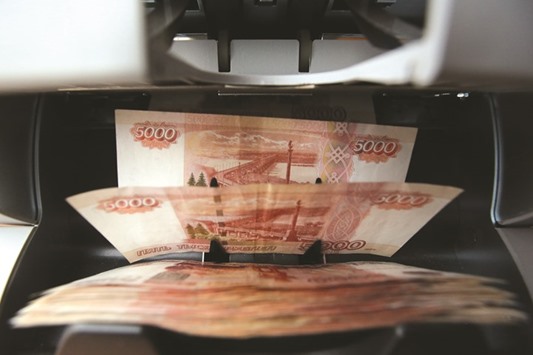The rouble’s “serious weakening,” as forecast by Russia’s Economy Ministry, may be seriously good for growth.
While the authorities in Russia have wavered this year over the benefits and disadvantages to the economy of a strong exchange rate, analysts are coming down on the side of depreciation. A weaker rouble is better for growth in the view of more than half the 19 analysts in a Bloomberg survey.
“As Russia is still export-orientated and many of the big Corps have revenues in US dollars, a weaker rouble is favoured over a too-strong rouble as it keeps them competitive in what remains their main source of income,” said Christopher Shiells, senior emerging-market analyst at Informa Global Markets in London.
Given the ministry’s updated baseline outlook released last week, Russia may get just what it needs to give the economy a pop after almost two years of recession. The rouble will end this year at 68 against the dollar, about 15% down from where it’s trading now, Economy Minister Maxim Oreshkin said on Thursday. Its average exchange rate will decline every year through 2020, according to the ministry.
What’s made the rouble a focal point of policy discussions in Russia this year is that it’s increasingly diverged from oil, prompting both the economy and finance ministries to call it overvalued, an assessment that put them at odds with the central bank.
The rift over the rouble reflects competing agendas between parts of the government and the central bank, which shifted to a free float in late 2014 and has pledged to avoid interventions unless the currency’s swings threaten financial stability. A stronger exchange rate gives added protection against inflation by making imports less expensive and eases the way for companies looking to bring equipment and technologies from abroad.
But the second-biggest currency rally in emerging markets this year is putting a dent into Russia’s budget intake, more than a third of which last year came from energy sales that are denominated in dollars. And with exports crucial to the little recovery Russia has seen, currency gains threaten competitiveness.
Nothing short of tensions with the US has made a difference this year for the rouble, which is up 7% against the dollar while oil has lost almost 3%. Given the central bank’s policy of maintaining elevated interest rates to fight inflation, the Russian currency’s appeal as a carry trade has frustrated the government’s attempts to guide the rouble weaker, which have ranged from verbal interventions to purchases of foreign exchange by the Finance Ministry.
Oreshkin believes that may be about to change as capital flows normalise and the price of crude is forecast with a “high probability” to slide to $40 a barrel. Those two factors will combine to bring the Russian currency to 68 against the dollar by the end of the year, according to the economy minister. The rouble lost 1.5% on Friday to 57.25.
“It helps exports,” said Cristian Maggio, an economist at TD Securities. “Since Russia is trying to develop a domestic industry that replaces a number of goods previously imported, the higher cost of imports and the lower cost of exports will incentivise the process and stimulate exports.”

Russian rouble banknotes pass through a money counting machine at a store in Moscow. A weaker rouble is better for growth in the view of more than half the 19 analysts in a Bloomberg survey.
